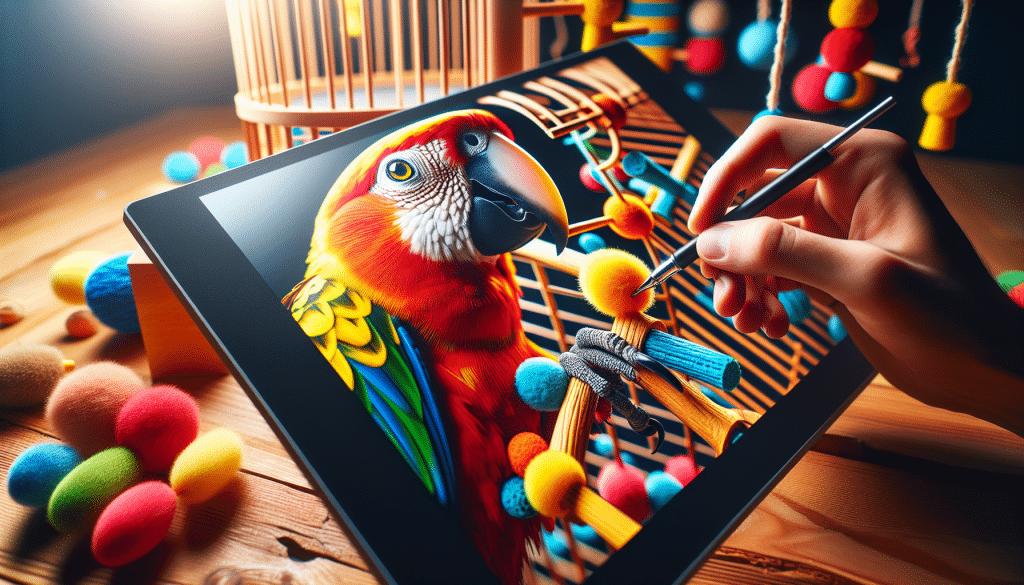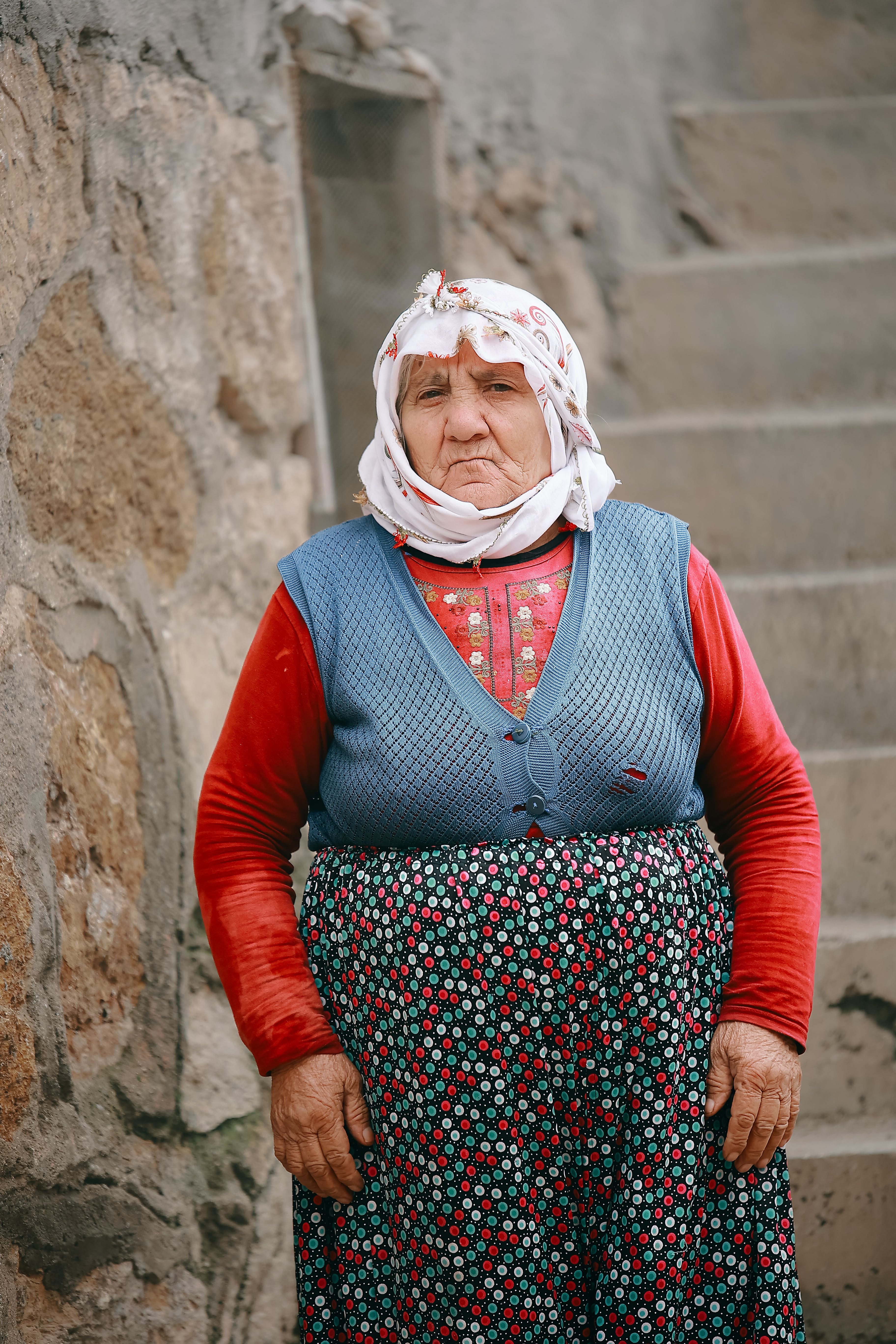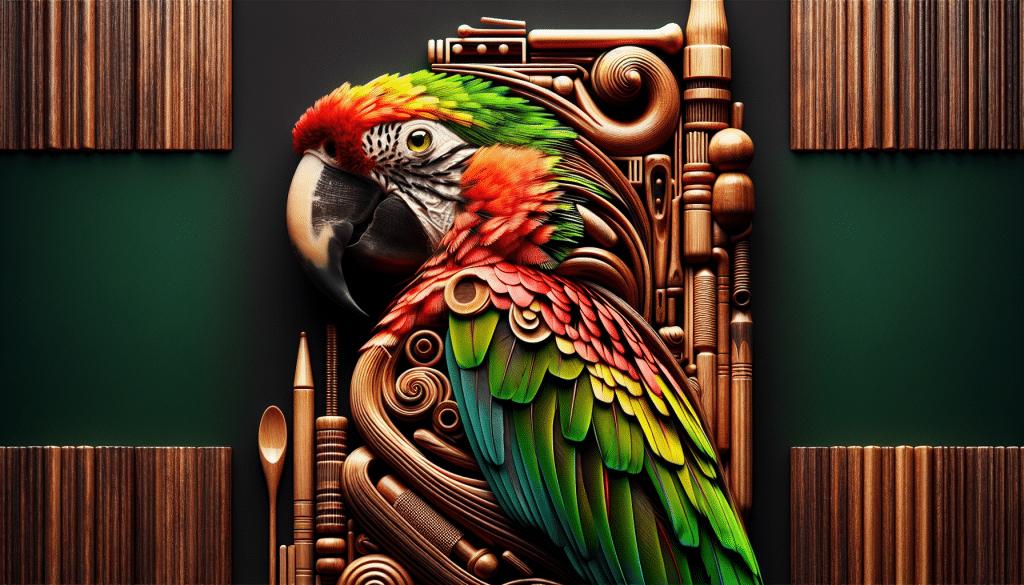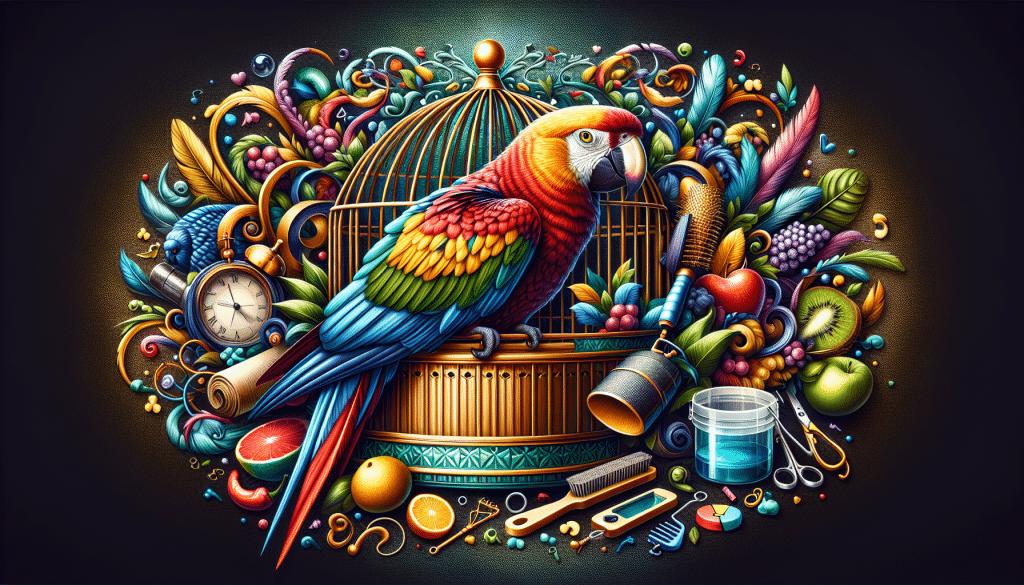So, you’ve decided to build a parrot cage from scratch, but you’re not exactly sure where to start. Don’t worry, because we’ve got you covered with these 10 easy steps that will guide you through the process. Whether you’re a seasoned DIY enthusiast or a beginner, this article will provide you with all the information you need to create a safe and comfortable living space for your feathered friend. From gathering the materials to putting on the final touches, follow along as we walk you through the process of building your very own parrot cage.

Understanding the Basics of a Parrot Cage
The importance of size in a parrot cage
When it comes to choosing a parrot cage, size matters. A spacious cage is essential for the health and well-being of your feathered friend. Parrots require ample space to move around, stretch their wings, and engage in natural behaviors like climbing and playing. A cramped cage can lead to boredom, stress, and even physical health issues. As a general rule, the cage should be large enough for your parrot to fully extend its wings without touching the sides and have enough room for various toys, perches, and food and water dishes.
Understanding the safety considerations for a parrot cage
Safety is paramount when it comes to selecting a parrot cage. Your parrot’s cage should be designed to protect it from potential hazards and ensure its overall well-being. Look for a cage with bars spaced closely enough together to prevent your parrot from getting its head or body stuck between them. Avoid cages with toxic materials, such as lead or zinc, as they can be harmful if ingested. Additionally, ensure that all doors, latches, and fasteners are secure and cannot be easily opened by your curious and clever parrot.
Necessary features in a parrot cage
A well-equipped parrot cage should have several essential features to cater to your feathered friend’s needs. Firstly, consider the presence of multiple perches at varying heights and thicknesses to promote foot exercise and health. Your parrot should have different options for resting and playing comfortably. Secondly, provide ample space to hang toys and enrichment items to keep your parrot mentally stimulated and engaged. Lastly, opt for a cage that allows for easy placement of food and water dishes, providing a convenient and accessible feeding area.
Determining the Appropriate Location for the Cage
Choosing the optimal room in your home
Selecting the right room for your parrot’s cage is crucial for its overall well-being. Consider a room where your parrot can be part of the household and receive social interaction while still having the option for peace and quiet when needed. Avoid placing the cage in a secluded or isolated area, as parrots are highly social creatures and thrive on interaction. Additionally, try to position the cage in a room that is well-ventilated and has good air circulation to prevent any respiratory issues for your parrot.
Considering light and temperature
Proper lighting and temperature are vital for your parrot’s health and happiness. Parrots need exposure to natural daylight, which provides them with essential vitamin D. Position the cage in a room with access to natural sunlight, but ensure that direct sunlight does not cause overheating or uncomfortable temperatures. Additionally, be mindful of drafts or areas with fluctuating temperatures, as they can be detrimental to your parrot’s well-being.
Understanding the impact of noise and activity levels
Parrots are sensitive to noise and activity levels, so it’s important to choose a location that strikes a balance. Avoid placing the cage in a room with excessive noise, such as near loud appliances or busy areas of the house. Loud noises can stress out your parrot and negatively impact its overall health. Similarly, consider the activity levels in the chosen room. While it’s important for your parrot to be part of the household, excessive commotion or constant disturbance can also lead to stress and anxiety.

Planning the Layout of Your Parrot Cage
The role of perches and their correct placement
Perches play a significant role in the comfort and well-being of your parrot. They provide a place to rest, exercise, and maintain healthy feet. Different types of perches, such as wooden or rope perches, offer varied textures and thicknesses, stimulating your parrot’s feet and helping prevent foot problems. When planning the layout of your cage, ensure the perches are positioned in a way that allows your parrot to move freely, hop between perches, and comfortably access its food and water dishes.
Planning for toys and enrichment
Toys and enrichment items are essential for keeping your parrot mentally stimulated and entertained. They help prevent boredom and encourage natural behaviors such as foraging and chewing. Consider a variety of toys that cater to different interests and textures, such as puzzle toys, chewable toys, and interactive toys. When planning the cage layout, ensure there is ample space to hang and rotate toys, allowing your parrot to explore and engage with its environment.
Considering food and water dish placement
Food and water dish placement within the parrot cage is crucial for your parrot’s access to nutrition and hydration. Place food and water dishes in an easily accessible area, away from perches and toys, to prevent contamination or spillage. Consider securing the dishes in place to prevent them from being knocked over or tipped. Additionally, ensure that the bowls are appropriately sized for your parrot, allowing it to comfortably eat and drink without difficulty.
Gathering the Required Materials
Choosing the appropriate cage material
When constructing or purchasing a parrot cage, selecting the right cage material is essential. Common options include stainless steel, wrought iron, and powder-coated steel. Stainless steel is highly durable, easy to clean, and non-toxic, making it an excellent choice for parrot cages. Wrought iron is also sturdy and long-lasting, but regular maintenance is required to prevent rust. Powder-coated steel cages offer a wide range of colors and designs while still being safe for your parrot, as long as the coating is non-toxic.
Identifying necessary tools for the build
If you choose to build your parrot cage, gathering the necessary tools is crucial for a successful construction process. Some common tools include a drill with appropriate drill bits, a screwdriver set, pliers, wire cutters, and a measuring tape. These tools will help you assemble the cage frame, attach the walls, and install the door securely.
Purchasing required fasteners and fixtures
To construct a sturdy and durable parrot cage, you will need various fasteners and fixtures. These include bolts, nuts, screws, washers, and clips. When purchasing these items, ensure they are made from non-toxic materials to maintain the safety of your parrot. Stainless steel or zinc-plated fasteners are commonly recommended for parrot cages due to their strength and lack of toxicity.

Constructing the Cage Frame
Building the base of the cage
The base of the cage provides stability and serves as the foundation for the entire structure. Start by cutting a piece of plywood or other suitable material to the desired dimensions for the base. Attach sturdy legs or casters to the corners of the base to elevate the cage and allow for easy movement. Ensure that the legs or casters are securely fastened to prevent any wobbling or instability.
Creating the cage walls
Once the base is constructed, it’s time to build the walls of the cage. Cut the chosen cage material, such as stainless steel or wrought iron, into panels of the appropriate size. Use the necessary tools to drill holes and secure the panels together with the chosen fasteners. Ensure that the bars are evenly spaced and securely attached to provide a safe and sturdy enclosure for your parrot.
Attaching the top of the cage
The top of the cage serves as both a protective cover and an attachment point for various accessories like hanging toys or a perch. Cut a piece of the chosen cage material to the dimensions of the cage’s top and securely attach it using appropriate fasteners. Consider leaving a portion of the top open or adding a hinged panel to allow for easy access to the cage interior for cleaning and maintenance.
Installing the Cage Door
Deciding on the best location for the door
The door of the cage is a crucial aspect, as it allows for easy access to your parrot and facilitates cleaning and maintenance. Carefully consider the placement of the door to ensure it is convenient for you to use while also being safe for your parrot. Avoid placing the door near perches or toys that could pose a potential hazard or cause injury to your bird. Position the door at a height that is easily reachable, allowing you to interact with your parrot comfortably.
Creating a safe and secure latch mechanism
To ensure the door is safe and secure, incorporate a reliable latch mechanism. Use a sturdy lock or latch that your parrot cannot easily manipulate or open. Consider a latch with a double-locking mechanism for added security. Regularly inspect the latch to ensure it is functioning properly and remains free from any damage or wear.
Ensuring the door is parrot-friendly
In addition to being secure, the cage door should also be parrot-friendly. Avoid doors with sharp edges or protruding parts that could injure your parrot. Ensure the door swings smoothly and does not have any gaps or spaces where your parrot could get caught. Regularly lubricate hinges and moving parts to ensure the door remains easy to open and close.

Creating a Comfortable Environment Inside the Cage
Installing appropriate perches for your parrot
Perches are essential components of a comfortable cage environment for your parrot. Choose perches of different textures, diameters, and heights to promote foot health and exercise. Avoid using sandpaper or rough surfaces, as they can cause irritation and foot problems. Consider positioning the perches at varying heights and angles to provide opportunities for your parrot to engage in natural behaviors, such as hopping and climbing.
Adding toys and enrichment items
To keep your parrot mentally stimulated and entertained, provide a variety of toys and enrichment items within the cage. These can include puzzle toys, chewable toys, swinging toys, and foraging toys. Rotate the toys regularly to maintain your parrot’s interest. Avoid overcrowding the cage with too many toys, as this can lead to clutter and stress for your parrot. Additionally, ensure that the toys are safe, non-toxic, and free from small parts that your parrot could swallow.
Setting up food and water dishes
Proper placement of food and water dishes is crucial for your parrot’s feeding habits. Ensure that the dishes are easily accessible and positioned away from areas where droppings are likely to fall. Consider using stainless steel or ceramic dishes that are durable, easy to clean, and resistant to tipping. Regularly clean and sanitize the dishes to maintain hygiene and prevent the growth of harmful bacteria.
Decorating Your Parrot Cage
Choosing non-toxic paints and materials
If you wish to decorate your parrot’s cage, it’s important to choose non-toxic paints and materials. Avoid using paints or coatings that contain harmful chemicals or additives. Opt for water-based, bird-safe paints that are specifically formulated for use on bird cages. When selecting decorations or accessories, ensure they are made from safe and non-toxic materials, as parrots may chew on or come into contact with them.
Making the cage visually stimulating for your parrot
Parrots are highly intelligent and curious creatures that benefit from visual stimulation. Consider adding colorful and visually engaging elements to the cage, such as hanging mirrors, colorful toys, or natural branches with leaves. These additions can provide entertainment and mental enrichment for your parrot, contributing to its overall well-being.
Keeping your parrot’s habits in mind while decorating
While decorating the cage, it’s important to consider your parrot’s habits and preferences. Some parrots may enjoy cozy hiding spots, while others prefer open spaces for maximum visibility. Observe your parrot’s behavior and adjust the decor accordingly. Avoid overcrowding the cage with excessive decorations, as this may restrict your parrot’s movements and cause stress.

Ensuring the Cage is Safe for Your Parrot
Using safe and non-toxic materials
To ensure the safety of your parrot, use cage materials that are safe and non-toxic. Avoid cages made from materials such as lead or zinc, as ingestion of these substances can be harmful to your parrot’s health. Additionally, choose fasteners and fixtures made from non-toxic materials to prevent any accidental ingestion or toxicity.
Checking for potential safety hazards
Regularly inspect the cage for potential safety hazards that could harm your parrot. Check for sharp edges, loose wires, or protruding parts that could cause injury. Ensure that all fasteners and fixtures are secure and free from rust. Monitor the cage for any signs of wear or damage, such as bent bars or weakened joints, and repair or replace them promptly to maintain a safe environment for your parrot.
Making sure the cage is escape-proof
One of the most crucial aspects of a parrot cage is its escape-proof design. Parrots are highly intelligent and can be skilled escape artists. Regularly check for any gaps, loose panels, or weak points in the cage that could allow your parrot to break free. Consider using additional measures such as locks or clips to reinforce the cage’s security.
Maintaining Your Parrot Cage Over Time
Cleaning and disinfecting the cage regularly
Maintaining a clean and hygienic cage is essential for your parrot’s health. Regularly clean all surfaces of the cage, including perches, toys, and dishes. Use bird-safe disinfectants or mild soap and water to remove any dirt or bacteria. Pay special attention to areas prone to waste buildup, such as corners or under perches. Rinse all surfaces thoroughly, ensuring no cleaning residue remains that could be harmful to your parrot.
Replacing worn-out toys and perches
Toys and perches can wear out over time due to your parrot’s play and natural activities. Regularly inspect toys and perches for signs of damage or wear. Replace any items that are broken, frayed, or no longer safe for use. Providing your parrot with new toys and perches not only keeps their environment fresh and stimulating but also ensures their safety and well-being.
Inspecting the cage for damage or potential safety issues
Regularly inspect the cage for any signs of damage or potential safety issues. Check for loose bolts, rust, or bent bars that could compromise the integrity of the cage. Look for any areas where your parrot may have caused damage or wear. Address any concerns promptly by repairing or replacing parts as needed. By conducting regular inspections, you can maintain a safe and secure cage environment for your parrot.
In conclusion, building or selecting the right parrot cage involves careful consideration of various factors. From understanding the importance of size and safety to planning the layout, gathering materials, and constructing the cage, each step plays a crucial role in providing a comfortable and secure home for your parrot. Additionally, ensuring the cage’s location, cleanliness, and ongoing maintenance are essential for your parrot’s overall health and well-being. By following these guidelines and providing a stimulating environment, you can create a safe and happy space for your beloved feathered companion.




